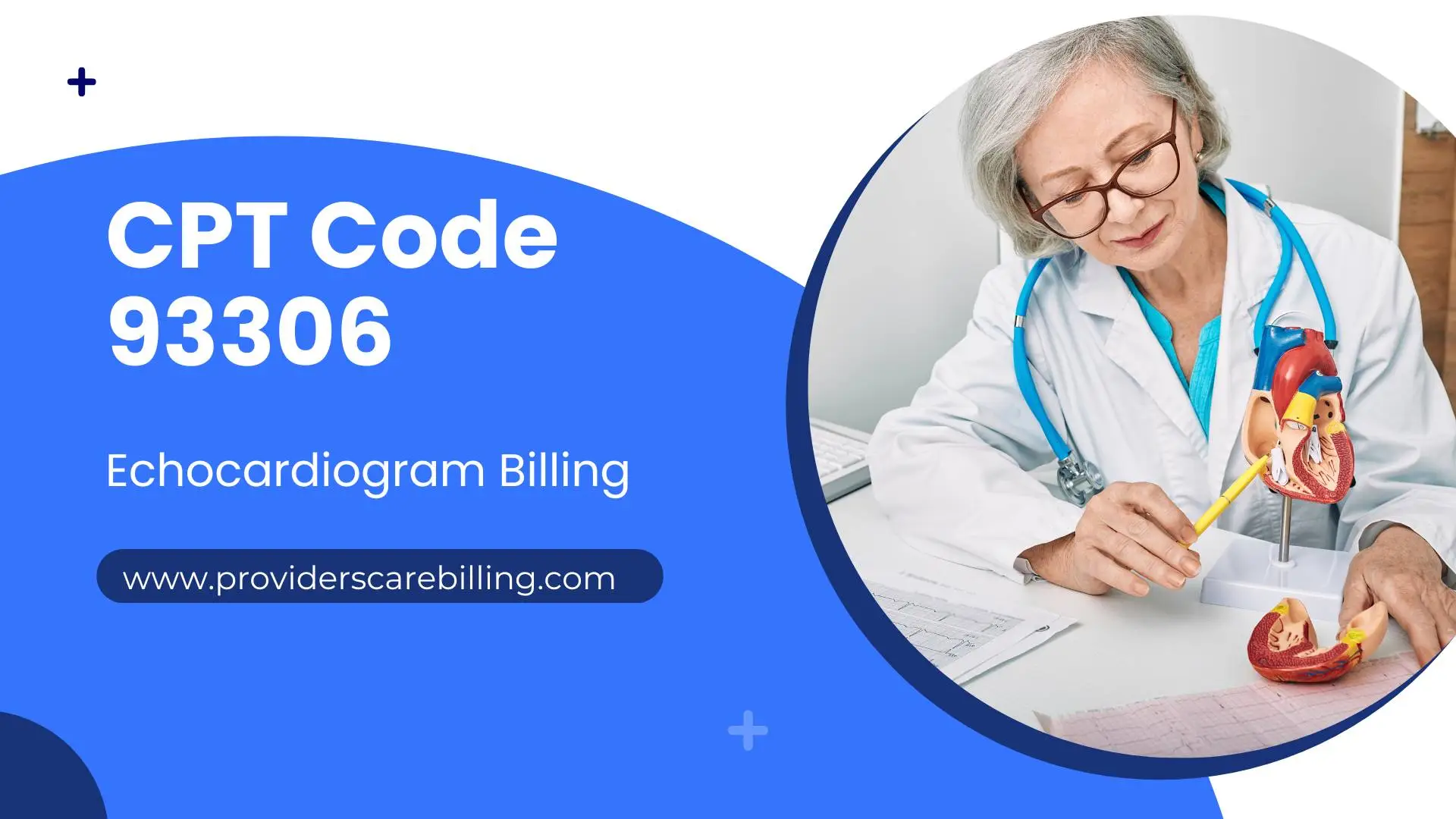Every rejected echocardiogram claim represents a failed revenue for your cardiology practice. With reimbursement rates tightening across healthcare, understanding CPT code 93306 is not only helpful but essential for the financial health of your practice. This complete guide breaks down everything you need to know about the most used echocardiogram CPT code and helps you to maximize reimbursement while maintaining observation in 2025’s always changing medical billing landscape.
What exactly is CPT Code 93306?
For a full transthoracic echocardiography with Doppler and color flow evaluation performed without contrast, you should use CPT number 93306. Ultrasound, as a diagnostic procedure, does not use contrast; rather, it uses transducers placed on the chest wall to obtain two-dimensional images showing the structure and function of the heart. Both aspects are covered by this code: the technical (the actual administration of the test) and professional (interpretation and reporting of results). One of the most used codes for cardiac diagnostics, 93306, provides the foundation for billing echocardiograms.
The providers see it as essential to visualize the chambers of the heart, valves, and patterns of blood flow; therefore, it is essential for the diagnosis of many cardiac conditions1620. It gives much more detailed information concerning anatomy and function than simpler ECG procedures, thus it helps in developing complete treatment plans by cardiologists.
Components required for CPT 93306
For a procedure to qualify for billing under CPT code 93306, it must include all of the following features:
- Color flow Doppler echocardiography
- M-mode recording
- A complete 2D real-time imaging with documentation
- M-mode recording
- Spectral Doppler echocardiography
The examination must consider specific cardiac systems that include:
- The aortic valve
- Left and right atria
- Left and right ventricles
- Mitral and tricuspid valves
If a component is not available or the study is not of sufficient scope, substitute codes such as 93307, 93320, or 93350 would be preferable.
When is cpt code 93306 medically necessary?
Understanding when CPT code 93306 meets medical necessity requirements is important for proper reimbursement. Insurance carriers typically approve this code for various clinical scenarios, including:
H3: Heart condition inspection
Echocardiograms that are coded under 93306 are used for the following purposes:
- Suspected endocarditis
- Native valvular heart disease
- Prosthetic heart valve function
- Acute myocardial infarction and coronary insufficiency
- Ventricular function abnormalities and cardiomyopathies
To ensure accurate billing, it’s important to include the correct CPT codes on your superbill—learn more about superbills and their role in medical billing.
Heart murmur evaluation
A full transthoracic echocardiography is usually suggested if a doctor looks at a patient and finds a heart murmur. The check helps know where the murmur comes from; it is commonly caused by irregular flow of blood in the heart. The 93306 approach accurately observes blood flow patterns and valve function using full images and Doppler tests.
Other Medical Necessities
Additional scenarios where 93306 is commonly indicated as follows
- Cardiac tumor and mass investigation
- Suspected cardiac thrombi and embolic sources
- Cardiac transplant and rejection monitoring
- Exposure to cardiotoxic agents
- Pericardial disease evaluation
CPT 93306 vs. Other echo codes: Understanding the differences
Medical billers must understand how 93306 differs from similar echocardiogram CPT codes to prevent coding errors and claim denials.
Complete vs. Limited echo
CPT 93308 is limited transthoracic echocardiography usually performed to answer one clinical question or as a f ollow-up to a prior study18. Unlike CPT 93306 which includes full echocardiogram. If complete echo is being paid for then appropriate documentation should explain why not all essential structures could be photographed.
Doppler components
Important details about diastolic function right ventricular function and valve stenosis can be seen by spectral Doppler imaging pulse-wave continuous-wave and tissue Doppler. Different codes like CPT 93321 for restricted spectrum Doppler or CPT 93325 for color Doppler are used if these components are paid separately.
Stress echocardiogram distinction
Other CPT codes that are used for stress echocardiograms are 93350, 93351. Both tests require specific coding practices and assess heart function under pharmaceutical stress or exercise.
Documentation requirements for 93306 CPT code
Clean claims require appropriate documentation, and optimal reimbursement is achieved with appropriate documentation. Proper documentation for CPT code 93306 is
- Complete evaluation of cardiac function
- Clinical indications for TTE procedure
- Interpretation of spectral and color
- Doppler findings Assessment of all necessary cardiac structures
The note should explain all parts of the complete echo well. If certain structures cannot be seen clearly, the note should say why; maybe to help the use of extra codes.
Billing and reimbursement guidelines
ICD-10 CM code selection
For the 93306 procedure18, always choose the most precise ICD-10 CM codes that support medical necessity. Keep in mind that evidence proving the full echocardiogram’s clinical necessity will be required by payers.
Modifier usage
- Be aware of applicable modifiers that might be needed with 93306. Such as
- TC (Technical Component)
- 26 (Professional Component)
- 59 (Distinct Procedural Service)
Frequency limitations
Echocardiogram studies are restricted by frequency by most insurance providers. In general, Medicare and other payers will only reimburse for several full echocardiograms within a short time period if there is unequivocal evidence of medical necessity.
Common billing mistakes to avoid
Even experienced medical billers make mistakes with echocardiogram coding.
1. Missing documentation for all required components
2. Upcoding limited studies as complete echocardiograms
3. Incorrect use of modifiers
4. Failing to establish medical necessity
Conclusion
Cardiovascular offices that want to make sure they get the most money back without giving up compliance need to know CPT code 93306 to stay alive. This code for complete transthoracic echocardiography with color flow and Doppler must exemplify clear medical necessity with documentation of every component. Providers will be able to enhance their revenue cycle while ensuring quality care to the cardiac patient when appreciating the nuances of echocardiography coding and the distinction between 93306 and its related codes.
Effective echocardiography billing involves staying abreast of payer regulations and the American Medical Association’s updates since coding guidelines evolve. You’ll be better equipped to deal with the complexity of cardiac diagnostic coding in 2025 and beyond if you possess the information in this manual.




